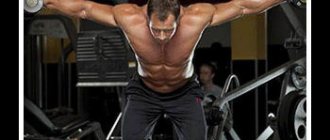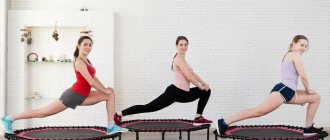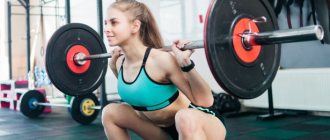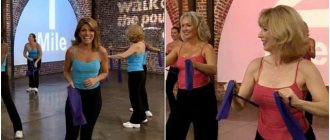Basic exercises should take priority in the training program - this rule is familiar to everyone who has once embarked on the path of improving their body. However, it happens that an athlete cannot perform complex multi-joint movements without a free weight machine (for example, squats) (even if adhering to the execution technique), or it is necessary to work specific muscles in isolation. In this situation, the leg press will help out.
- How to do a lying leg press correctly: features of the exercise and working muscles
- Leg press machine
- The weight of an empty platform in most designs is 25 kg, so it is advisable for beginners to master the leg press technique without additional weights and by setting the correct angle of the plate.
- Benefits of the Leg Press
- Performing a leg press
- Table: Features of muscle activation depending on the position of the feet on the platform
- Leg press technique: sequence of actions
- Video: Technique and nuances of performing leg presses in a machine
- Recommendations
What is this
Leg press (or platform press on a machine) – basic , i.e. multi-joint (hip, knee and ankle joints are involved) exercise for the leg muscles in the simulator at an angle of 45 degrees, which consists of bending and then extending the legs.
As a rule, big, pumped up guys treat this exercise on a machine with “coldness”, assuring that the squat is a much more important exercise for mass growth. Well, let's find out!
How much does the exercise platform weigh?
This is an interesting but difficult question, because... Manufacturers do not indicate the empty weight of the bench press, and it is not standardized. Let's give examples: the weight of the platform of the BT-202 simulator is 60 kg, in some gyms trainers talk about 25-30 kg.
However, do not rush to rejoice and add these 60 kilos to your working weight. The fact is that the load in simulators in which the movement is performed at an angle to the base (in this case it is 45 degrees) will be calculated as follows: the sine of this angle, i.e. 0.7, multiplied by the weight of the platform - i.e. from 60 kg. you will get a load of 42 kg, from 30 - 21.
Contraindications for leg press
There are a number of contraindications for performing leg presses that must be taken into account. Among them are:
- There is no need to resort to heavy loads for those who have intervertebral hernias or other problems with the spine.
- Scoliosis or lordosis may be the main reason to exercise in moderation and use only light weights during approaches. Also, such people are recommended to use a special athletic belt, which will help slightly reduce the load. It is worth considering that you should not tighten it too much, and breathing, even with a belt, should be even and deep.
- Those who have suffered a knee or ligament injury in the past should avoid leg presses. New activities can contribute to the recurrence of injuries and provoke new complications.
When starting a leg press in a machine, you must take into account all its features, and also pay attention to some contraindications. The most important thing is to approach it with full responsibility and work for results – efficiently and diligently.
What muscles work
The platform press can be performed in three positions, which will differ in the angle of inclination and, accordingly, in the targeted muscles. What does each of them download?
In a classic simulator at an angle of 45 degrees
This is the good old incline leg press (or, as they also say, incline), with a 98% probability this is exactly what you should do in your gym. It is easy to use, versatile and extremely popular among gym goers.
There won’t be much of a surprise here, but we will additionally note which muscles do not work in this machine: this is where the special benefit of the platform press lies. So, the exercise is designed to strengthen:
- on the anterior biceps of the thigh,
- inner and back thighs,
- gluteal muscles.
In addition, we would like to add that the leg press involves the hip, knee and ankle joints.
In vertical
Street leg press machine
In addition to the classic leg press at an angle, there is also a vertical horizontal platform bench press. This is a not very well known variation that is extremely rare to find in the gym. With a vertical leg press, the platform is perpendicular to your body. The movement is carried out in a short amplitude.
This allows you to isolate the load on the lower part of the quadriceps (teardrop muscle), which will make the leg bulkier in the lower thigh, closer to the knee.
If you need just such a load, then you can perform this exercise in a Smith machine; for normal execution, you only need the help of an experienced partner who will open and close the safety mechanisms.
Sitting
Or horizontal leg press. A more common option than the previous one, but not as much as the classic one. The exercise is also a basic one; the main movement in it is the push. It is usually used to work the muscles of the anterior thigh.
So, what muscles are involved:
- main – quadriceps (quadriceps femoris muscle),
- synergists – gluteus maximus, adductor magnus, soleus,
- dynamic stabilizers – hamstrings, calf.
Efficiency
- Simple, clear technique. Everything is extremely transparent and understandable. In terms of technique, this exercise is much simpler than squats with a barbell; of course, in terms of effectiveness it lags behind them, but not by much. It is always easier for beginners to learn how to do a leg press than to learn how to squat correctly.
- Great variability. There are several variations of the leg press, in which, with different leg positions, the emphasis shifts to different muscle groups.
- Improved blood flow. When performing a leg press, blood circulation in the pelvic organs increases, which leads to the production of testosterone, which is necessary for muscle growth and improved blood flow to the female organ (and as a pleasant bonus, it also stimulates libido











